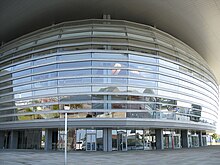
Copenhagen Business School often abbreviated and referred to as CBS, is a public university situated in Copenhagen, Denmark and is considered one of the most prestigious business schools in Western Europe and the world.

Amalienborg is the official residence for the Danish royal family and is located in Copenhagen. Frederick VIII's palace complex has four identical Classical façades, effectively four palaces, with Rococo interiors, laid around an octagonal courtyard. At the centre is a large equestrian statue of Frederick V. Amalienborg was originally built for four noble families, but after Christiansborg Palace burned in 1794 the royal family bought the palaces and moved in. Over the years various monarchs and their families have lived there, including today's King Frederik X and Queen Mary.

Christiansborg Palace is a palace and government building on the islet of Slotsholmen in central Copenhagen, Denmark. It is the seat of the Danish Parliament, the Danish Prime Minister's Office, and the Supreme Court of Denmark. Also, several parts of the palace are used by the Danish monarch, including the Royal Reception Rooms, the Palace Chapel and the Royal Stables.

Arnold Mærsk Mc-Kinney Møller was a Danish shipping magnate. He was a longtime figure at A.P. Moller–Maersk Group, which was founded by his father.
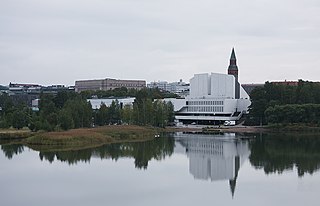
The Finlandia Hall is a congress and event venue in the centre of Helsinki on the Töölönlahti Bay, owned by the City of Helsinki. The building, which was designed by architect Alvar Aalto, was completed in 1971. Every detail in the building is designed by Aalto. The designs were completed in 1962, with building taking place between 1967 and 1971. The Congress Wing was designed in 1970 and built in 1973–1975. In 2011, the building was expanded with new exhibition and meeting facilities. Finlandia Hall is known as the venue for the OSCE Summit held in August 1975, attended by 35 world leaders, including the leader of the Soviet Union, Leonid Brezhnev, and the President of the United States, Gerald Ford.

The Istana Budaya or also known as the Palace of Culture, is Malaysia's main venue for all types of theatre including musical theatre, operetta, classical concerts and opera from local and international performances. It is located in the heart of Kuala Lumpur city, next to the National Art Gallery.
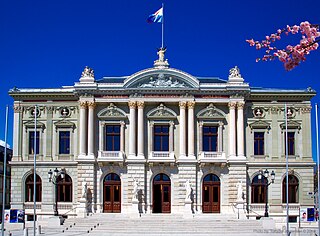
Grand Théâtre de Genève is an opera house in Geneva, Switzerland.

Henning Larsen, Hon. FAIA was a Danish architect. He is internationally known for the Ministry of Foreign Affairs building in Riyadh and the Copenhagen Opera House.

Det Ny Teater is an established theatre in Copenhagen, Denmark, first opened in 1908. It is based in a building which spans a passage between Vesterbrogade and Gammel Kongevej in Copenhagen's theatre district on the border between Vesterbro and Frederiksberg.
The Oslo Opera House is the home of the Norwegian National Opera and Ballet, and the national opera house in Norway. The building is situated in the Bjørvika neighbourhood of central Oslo, at the head of the Oslofjord. It is operated by Statsbygg, the government agency which manages property for the Norwegian government. The structure contains 1,100 rooms in a total area of 49,000 m2 (530,000 sq ft). The main auditorium seats 1,364 and two other performance spaces can seat 200 and 400. The main stage is 16 m (52 ft) wide and 40 m (130 ft) deep. The angled exterior surfaces of the building are covered with marble from Carrara, Italy and white granite and make it appear to rise from the water. It is the largest cultural building constructed in Norway since Nidarosdomen was completed circa 1300.

The architecture of Denmark has its origins in the Viking Age, richly revealed by archaeological finds. It became firmly established in the Middle Ages when first Romanesque, then Gothic churches and cathedrals sprang up throughout the country. It was during this period that, in a country with little access to stone, brick became the construction material of choice, not just for churches but also for fortifications and castles.

Amaliehaven is a small park located between Amalienborg Palace and the waterfront in the Frederiksstaden neighbourhood of central Copenhagen, Denmark. It was established in 1983 as a gift from the A.P. Møller and the Chastine McKinney Møller Foundation. The park is part of the so-called Frederiksgade axis, the shorter but more distinctive of the two axes on which Frederiksstaden is centred.

Frederiksgade is a street in the Frederiksstaden neighbourhood of central Copenhagen. It runs east from Store Kongensgade to Toldbodgade on the waterfront, passing the Marble Church, Bredgade and Amaliegade on the way. At the Marble Church the street splits and curves around both sides of the church before rejoining on its other side.
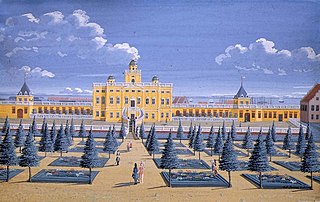
Sophie Amalienborg was a pleasure palace roughly located where Amalienborg stands today in Copenhagen, Denmark. It was built by Queen Consort Sophie Amalie who lived there until her death in 1685 after her husband, King Frederick III, died a few years prior to its completion.

Esplanaden is a street in Copenhagen, Denmark. It extends eastwards from Store Kongensgade and runs along the south side of the city's 17th-century fortress Kastellet and Churchillparken until it reaches the waterfront at Nordre Toldbod, just south of Langelinie, passing Amaliegade, Bredgade and Grønningen on the way. It marks the northern border of the Frederiksstaden district.
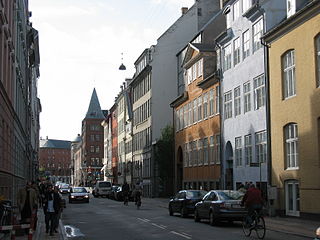
Toldbodgade is a street in central Copenhagen, Denmark. It extends north from Nyhavn at the Nyhavn Bridge, continuing Holberggade, passes Sankt Annæ Plads after just one block, and continues straight until it reaches West India Warehouse where it makes a sharp left turn which connects it to Amaliegade, its parallel street, at the rear of the Design Museum.
Events from the year 2012 in the Denmark.
A bibliography of books and material related to the Architecture of Denmark:
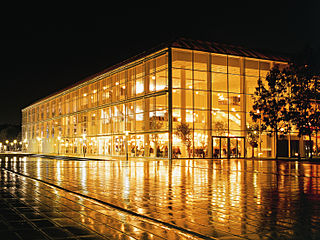
Musikhuset Aarhus is a large concert hall complex in Aarhus, Denmark. Located in the city centre, Musikhuset is Aarhus' main venue for music and with seating for more than 3,600 people in total, it is the largest concert hall in Scandinavia. Musikhuset Aarhus was designed by Kjær & Richter and built in 1979-1982, commissioned by Aarhus Municipality.
The Gotved Institute is a gymnastics centre on Vodroffsvej in the Frederiksberg district of Copenhagen, Denmark. Its building was completed in 1898 to design by Peder Vilhelm Jensen-Klint and is listed.



